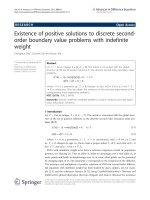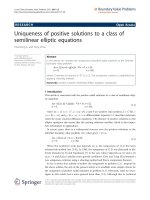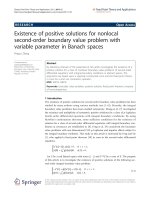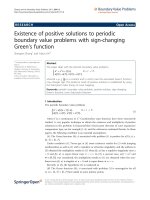Báo cáo toán học: " Existence of Positive Solutions for Nonlinear m-point Boundary Value Problems on Time Scales" doc
Bạn đang xem bản rút gọn của tài liệu. Xem và tải ngay bản đầy đủ của tài liệu tại đây (342.84 KB, 24 trang )
This Provisional PDF corresponds to the article as it appeared upon acceptance. Fully formatted
PDF and full text (HTML) versions will be made available soon.
Existence of Positive Solutions for Nonlinear m-point Boundary Value Problems
on Time Scales
Boundary Value Problems 2012, 2012:4 doi:10.1186/1687-2770-2012-4
Junfang Zhao ()
Hairong Lian ()
Weigao Ge ()
ISSN 1687-2770
Article type Research
Submission date 4 May 2011
Acceptance date 17 January 2012
Publication date 17 January 2012
Article URL />This peer-reviewed article was published immediately upon acceptance. It can be downloaded,
printed and distributed freely for any purposes (see copyright notice below).
For information about publishing your research in Boundary Value Problems go to
/>For information about other SpringerOpen publications go to
Boundary Value Problems
© 2012 Zhao et al. ; licensee Springer.
This is an open access article distributed under the terms of the Creative Commons Attribution License ( />which permits unrestricted use, distribution, and reproduction in any medium, provided the original work is properly cited.
Existence of positive solutions for nonlinear
m-point boundary value problems on time scales
Junfang Zhao
∗1
, Hairong Lian
1
and Weigao Ge
2
1
School of Mathematics and Physics, China University of Geosciences, Beijing 100083, P.R. China
2
Department of Mathematics, Beijing Institute of Technology, Beijing 100081, P.R. China
∗
Corresponding author: zhao
Abstract
In this article, we study the following m-point boundary value problem on time scales,
(φ
p
(u
∆
(t)))
∇
+ h(t)f(t, u(t)) = 0, t ∈ (0, T )
T
,
u(0) − δu
∆
(0) =
m−2
i=1
β
i
u
∆
(ξ
i
), u
∆
(T ) = 0,
where T is a time scale such that 0, T ∈ T, δ, β
i
> 0, i = 1, . . . , m − 2,
φ
p
(s) = |s|
p−2
s, p > 1, h ∈ C
ld
((0, T ), (0, +∞)), and f ∈ C([0, +∞), (0, +∞)),
0 < ξ
1
< ξ
2
< · · · < ξ
m−2
< T ∈ T. By using several well-known fixed point theorems
in a cone, the existence of at least one, two, or three positive solutions are obtained. Examples
are also given in this article.
AMS Subject Classification: 34B10; 34B18; 39A10.
1
Keywords: positive solutions; cone; multi-point; boundary value problem; time scale.
1 Introduction
The study of dynamic equations on time scales goes back to its founder Hilger [1], and is a
new area of still theoretical exploration in mathematics. Motivating the subject is the notion
that dynamic equations on time scales can build bridges between continuous and discrete
mathematics. Further, the study of time scales has led to several important applications, e.g.,
in the study of insect population models, neural networks, heat transfer, epidemic models,
etc. [2].
Multipoint boundary value problems of ordinary differential equations (BVPs for short)
arise in a variety of different areas of applied mathematics and physics. For example, the
vibrations of a guy wire of a uniform cross section and composed of N parts of different
densities can be set up as a multi-point boundary value problem [3]. Many problems in the
theory of elastic stability can be handled by the method of multi-point problems [4]. Small
size bridges are often designed with two supported points, which leads into a standard two-
point boundary value condition and large size bridges are sometimes contrived with multi-
point supports, which corresponds to a multi-point boundary value condition [5]. The study
of multi-point BVPs for linear second-order ordinary differential equations was initiated by
Il’in and Moiseev [6]. Since then many authors have studied more general nonlinear multi-
point BVPs, and the multi-point BVP on time scales can be seen as a generalization of that
in ordinary differential equations.
Recently, the existence and multiplicity of positive solutions for nonlinear differential
equations on time scales have been studied by some authors [7–11], and there has been some
merging of existence of positive solutions to BVPs with p-Laplacian on time scales [12–19].
He [20] studied
(φ
p
(u
∆
(t)))
∇
+ a(t)f(t) = 0, t ∈ (0, T )
T
, (1.1)
2
subject to one of the following boundary conditions
u(0) − B
0
(u
∆
(η)) = 0, u
∆
(T ) = 0,
u
∆
(0) = 0, u(T ) − B
1
(u
∆
(η)) = 0,
(1.2)
where η ∈ (0, T ) ∩ T. By using a double fixed-point theorem, the authors get the existence
of at least two positive solutions to BVP (1.1) and (1.2).
Anderson [21] studied
−u
∆∇
(t) = ηa(t)f(u(t)), t ∈ (t
1
, t
n
)
T
, (1.3)
subject to one of the following boundary conditions
u(t
1
) =
n−1
i=2
α
i
u(t
i
), u
∆
(t
n
) = 0, (1.4)
u
∆
(t
1
) = 0, u(t
n
) =
n−1
i=2
α
i
u(t
i
), (1.5)
by using a functional-type cone expansion–compression fixed-point theorem, the author gets
the existence of at least one positive solution to BVP (1.3), (1.4) and BVP (1.3), (1.5).
However, to the best of the authors’ knowledge, up to now, there are few articles con-
cerned with the existence of m-point boundary value problem with p-Laplacian on time
scales. So, in this article, we try to fill this gap. Motivated by the article mentioned above,
in this article, we consider the following m-point BVP with one-dimensional p-Laplacian,
(φ
p
(u
∆
(t)))
∇
+ h(t)f(t, u(t)) = 0, t ∈ (0, T )
T
,
u(0) − δu
∆
(0) =
m−2
i=1
β
i
u
∆
(ξ
i
), u
∆
(T ) = 0,
(1.6)
where φ
p
(s) = |s|
p−2
s, p > 1, h ∈ C
ld
((0, T ), (0, +∞)), 0 < ξ
1
< ξ
2
< · · · < ξ
m−2
< T ∈ T.
δ, β
i
> 0, i = 1, . . . , m − 2.
We will assume throughout
(S1) h ∈ C
ld
((0, T ), [0, ∞)) such that
T
0
h(s)∇s < ∞;
3
(S2) f ∈ C([0, ∞), (0, ∞)), f ≡ 0 on [0, T ]
T
.
(S3) By φ
q
we denote the inverse to φ
p
, where
1
p
+
1
q
= 1.
(S4) By t ∈ [a, b] we mean that t ∈ [a, b] ∩ T, where 0 ≤ a ≤ b ≤ T.
2 Preliminaries
In this section, we will give some background materials on time scales.
Definition 2.1. [7, 22] For t < sup T and t > inf T, define the forward jump operator σ
and the backward jump operator ρ, respectively,
σ(t) = inf{τ ∈ T|τ > t} ∈ T, ρ(r) = sup{τ ∈ T|τ < r} ∈ T
for all r, t ∈ T. If σ(t) > t, t is said to be right scattered, and if ρ(r) < r, r is said to be left
scattered. If σ(t) = t, t is said to be right dense, and if ρ(r) = r, r is said to be left dense.
If T has a right scattered minimum m, define T
κ
= T − {m}; Otherwise set T
κ
= T. The
backward graininess µ
b
: T
κ
→ R
+
0
is defined by
µ
b
(t) = t − ρ(t).
If T has a left scattered maximum M, define T
κ
= T − {M}; Otherwise set T
κ
= T. The
forward graininess µ
f
: T
κ
→ R
+
0
is defined by
µ
f
(t) = σ(t) − t.
Definition 2.2. [7, 22] For x : T → R and t ∈ T
κ
, we define the “∆” derivative of
x(t), x
∆
(t), to be the number (when it exists), with the property that, for any ε > 0, there
is neighborhood U of t such that
[x(σ(t)) − x(s)] − x
∆
(t)[σ(t) − s]
< ε|σ(t) − s|
for all s ∈ U. For x : T → R and t ∈ T
κ
, we define the “∇” derivative of x(t), x
∆
(t), to be
the number(when it exists), with the property that, for any ε > 0, there is a neighborhood
V of t such that
[x(ρ(t)) − x(s)] − x
∇
(t)[ρ(t) − s]
< ε|ρ(t) − s|
for all s ∈ V.
4
Definition 2.3. [22] If F
∆
(t) = f(t), then we define the “∆” integral by
t
a
f(s)∆s = F (t) − F (a).
If F
∇
(t) = f(t), then we define the “∇” integral by
t
a
f(s)∇s = F (t) − F (a).
Lemma 2.1. [23] The following formulas hold:
(i) (
t
a
f(t)∆s)
∆
= f(t),
(ii) (
t
a
f(t)∆s)
∇
= f(ρ(t)),
(iii) (
t
a
f(t)∇s)
∆
= f(σ(t)),
(iv) (
t
a
f(t)∇s)
∇
= f(t).
Lemma 2.2. [7, Theorem 1.75 in p. 28] If f ∈ C
rd
and t ∈ T
κ
, then
σ(t)
t
f(τ)∆τ = µ
f
(t)f(t).
According to [23, Theorem 1.30 in p. 9], we have the following lemma, which can be
proved easily. Here, we omit it.
Lemma 2.3. Let a, b ∈ T and f ∈ C
ld
.
(i) If T = R, then
b
a
f(t)∇t =
b
a
f(t)dt,
where the integral on the right is the usual Riemann integral from calculus.
(ii) If [a, b] consists of only isolated points, then
b
a
f(t)∇t =
t∈(a,b]
µ
b
(t)f(t), if a < b,
0, if a = b,
−
t∈(b,a]
µ
b
(t)f(t), if a > b.
5
(iii) If T = hZ = {hk : k ∈ Z}, where h > 0, then
b
a
f(t)∇t =
b
h
k=
a
h
+1
f(kh)h, if a < b,
0, if a = b,
−
a
h
k=
b
h
+1
f(kh)h, if a > b.
(iv) If T = Z, then
b
a
f(t)∇t =
b
t=a+1
f(t), if a < b,
0, if a = b,
−
a
t=b+1
f(t), if a > b.
In what follows, we list the fixed point theorems that will be used in this article.
Theorem 2.4. [24] Let E be a Banach space and P ⊂ E be a cone. Suppose Ω
1
, Ω
2
⊂ E
open and bounded, 0 ∈ Ω
1
⊂ Ω
1
⊂ Ω
2
⊂ Ω
2
. Assume A : (Ω
2
\ Ω
1
) ∩ P → P is completely
continuous. If one of the following conditions holds
(i) Ax ≤ x, ∀x ∈ ∂Ω
1
∩ P, Ax ≥ x, ∀x ∈ ∂Ω
2
∩ P;
(ii) Ax ≥ x, ∀x ∈ ∂Ω
1
∩ P, Ax ≤ x, ∀x ∈ ∂Ω
2
∩ P.
Then, A has a fixed point in (Ω
2
\ Ω
1
) ∩ P .
Theorem 2.5. [25] Let P be a cone in the real Banach space E. Set
P (γ, r) = {u ∈ P, γ(u) < r}.
If α and γ are increasing, nonnegative continuous functionals on P, let θ be a nonnegative
continuous functional on P with θ(0) = 0 such that for some positive constants r, M,
γ(u) ≤ θ(u) ≤ α(u) and u ≤ Mγ(u).
6
for all u ∈ P (γ, r). Further, suppose there exists positive numbers a < b < r such that
θ(λu) ≤ λθ(u) for all 0 ≤ λ ≤ 1, u ∈ ∂P (θ, b).
If A : P (γ, r) → P is completely continuous operator satisfying
(i) γ(Au) > r for all u ∈ ∂P (γ, r);
(ii) θ(Au) < b for all u ∈ ∂P (θ, r);
(iii) P (α, b) = ∅ and α(Au) > a for all u ∈ ∂P (α, a).
Then, A has at least two fixed points u
1
and u
2
such that
a < α(u
1
), with θ(u
1
) < b, and b < θ(u
2
), with γ(u
1
) < r,
Let a, b, c be constants, P
r
= {u ∈ P : u < r}, P (ψ, b, d) = {u ∈ P : a ≤ ψ(u), u ≤
b}.
Theorem 2.6. [26] Let A : P
c
→ P
c
be a completely continuous map and ψ be a nonneg-
ative continuous concave functional on P such that for ∀u ∈ P
c
, there holds ψ(u) ≤ u.
Suppose there exist a, b, d with 0 < a < b < d ≤ c such that
(i) {u ∈ P (ψ, b, d) : ψ(u) > b} = ∅ and ψ(Au) > b for all u ∈ P (ψ, b, d);
(ii) Au < a for all u ∈ P
a
;
(iii) ψ(Au) > b for all u ∈ P (ψ, b, d) with Au > d.
Then, A has at least three fixed points u
1
, u
2
, and u
3
satisfying
u
1
< a, b < α(u
2
), u
3
> a, and u
3
< b.
Let the Banach space E = C
ld
[0, T ] be endowed with the norm u = sup
t∈[0,T ]
u(t), and
cone P ⊂ E is defined as
P = {u ∈ E, u(t) ≥ 0 for t ∈ [0, T ] and u
∆∇
(t) ≤ 0 for t ∈ (0, T ), u
∆
(T ) = 0}.
7
It is obvious that u = u(T ) for u ∈ P. Define A : P → E as
(Au)(t) =
t
0
φ
q
T
s
h(τ)f(τ, u(τ ))∇τ
∆s + δφ
q
T
0
h(s)f(s, u(s))∇s
+
m−2
i=1
β
i
φ
q
T
ξ
i
h(s)f(s, u(s))∇s
for t ∈ [0, T ].
In what follows, we give the main lemmas which are important for getting the main
results.
Lemma 2.7. A : P → P is completely continuous.
Proof. First, we try to prove that A : P → P.
(Au)
∆
(t) = φ
q
T
t
h(s)f(s, u(s))∇s
.
Thus, (Au)
∆
(T ) = 0 and by Lemma 2.1 we have (Au)
∆∇
(t) = −h(t)f(t, u(t)) ≤ 0 for
t ∈ (0, T ). Consequently, A : P → P.
By standard argument we can prove that A is completely continuous. For more details,
see [27]. The proof is complete.
Lemma 2.8. For u ∈ P, there holds u(t) ≥
t
T
u for t ∈ [0, T ].
Proof. For u ∈ P, we have u
∆∇
(t) ≤ 0, it follows that u
∆
(t) is non-increasing. Therefore, for
0 < t < T,
u(t) − u(0) =
t
0
u
∆
(s)∆s ≥ tu
∆
(t) (2.1)
and
u(T ) − u(t) =
T
t
u
∆
(s)∆s ≤ (T − t)u
∆
(t), (2.2)
thus
u(T ) − u(0) ≤ T u
∆
(t). (2.3)
Combining (2.1) and (2.3) we have
T (u(t) − u(0)) ≥ T tu
∆
(t) ≥ t(u(T ) − u(0)),
as u(0) ≥ 0, it is immediate that
u(t) ≥
tu(T ) + (T − t)u(0)
T
≥
t
T
u(T ) =
t
T
u.
The proof is complete.
8
3 Existence of at least one positive solution
First, we give some notations. Set
Λ =
δ +
m−2
i=1
β
i
+ T
φ
q
T
0
h(s)∇s
,
B =
ξ
1
T
δφ
q
T
0
h(s)∇s
+
m−2
i=1
β
i
φ
q
T
ξ
i
h(s)∇s
+
T
0
φ
q
T
s
h(τ)∇τ
∆s
.
Theorem 3.1. Assume in addition to (S1) and (S2), the following conditions are satisfied,
there exists 0 < r <
ξ
1
ρ
T
< ρ < ∞ such that
(H1) f(t, u) ≤ φ
p
(
u
Λ
), for t ∈ [0, T ], u ∈ [0, r];
(H2) f(t, u) ≥ φ
p
(
u
B
), for t ∈ [ξ
1
, T ], u ∈ [
ξ
1
ρ
T
, ρ].
Then, BVP (1.6) has at least one positive solution.
Proof. Cone P is defined as above. By Lemma 2.7 we know that A : P → P is completely
continuous. Set Ω
r
= {u ∈ E, u < r}. In view of (H1), for u ∈ ∂Ω
r
∩ P,
Au = (Au)(T ) = δφ
q
T
0
h(s)f(s, u(s))∇s
+
m−2
i=1
β
i
φ
q
T
ξ
i
h(s)f(s, u(s))∇s
+
T
0
φ
q
T
s
h(τ)f(τ, u(τ ))∇τ
∆s
≤
δ +
m−2
i=1
β
i
+ T
φ
q
T
0
φ
p
(
u(s)
Λ
)h(s)∇s
≤
u
Λ
δ +
m−2
i=1
β
i
+ T
φ
q
T
0
h(s)∇s
≤ u,
which means that for u ∈ ∂Ω
r
∩ P, Au ≤ u.
On the other hand, for u ∈ P, in view of Lemma 2.8, there holds u(t) ≥
ξ
1
T
u, for
9
t ∈ [ξ
1
, T ]. Denote Ω
ρ
= {u ∈ E, u < ρ}. Then for u ∈ ∂Ω
ρ
∩ P, considering (H2), we have
Au = (Au)(T ) = δφ
q
T
0
h(s)f(s, u(s))∇s
+
m−2
i=1
β
i
φ
q
T
ξ
i
h(s)f(s, u(s))∇s
+
T
0
φ
q
T
s
h(τ)f(τ, u(τ ))∇τ
∆s
≥ δφ
q
T
0
φ
p
(
u(s)
B
)h(s)∇s
+
m−2
i=1
β
i
φ
q
T
ξ
i
φ
p
(
u(s)
B
)h(s)∇s
+
T
0
φ
q
T
s
φ
p
(
u(τ)
B
)h(τ)∇τ
∆s
≥
ξ
1
u
T B
δφ
q
T
0
h(s)∇s
+
m−2
i=1
β
i
φ
q
T
ξ
i
h(s)∇s
+
T
0
φ
q
T
s
h(τ)∇τ
∆s
= u,
which implies that for u ∈ ∂Ω
ρ
∩P, Au ≥ u. Therefore, the immediate result of Theorem
2.4 is that A has at least one fixed point u ∈ (Ω
ρ
\ Ω
r
) ∩ P. Also, it is obvious that the fixed
point of A in cone P is equivalent to the positive solution of BVP (1.6), this yields that BVP
(1.6) has at least one positive solution u satisfies r ≤ u ≤ ρ. The proof is complete.
Here is an example.
Example 3.2. Let T = P
1,1
=
∞
k=0
[2k, 2k + 1]. Consider the following four point BVP on
time scale P
1,1
.
x
∆∇
(t) + f(t, u(t)) = 0, t ∈ [0, T ]
T
,
x(0) − 2x
∆
(0) = x
∆
(2) + x
∆
(3), x
∆
(4) = 0,
(3.1)
where
f(t, u) =
tu
128
, 0 ≤ u ≤ 100,
39t
512
(u − 100) +
25t
32
, 100 ≤ u ≤ 500,
tu
16
, u ≥ 500,
10
and h(t) = 1, T = 4, ξ
1
= 2, ξ
2
= 3, δ = 2, β
1
= β
2
= 1, p = q = 2. In what follows, we try to
calculate Λ, B. By Lemmas 2.2 and 2.3, we have
Λ =
δ +
m−2
i=1
β
i
+ T
φ
q
T
0
h(s)∇s
= (2 + 1 + 1 + 4)
4
0
∇s
= 8 ×
1
0
ds +
3
2
ds +
2
1
∇s +
4
3
∇s
= 8 ×
1
0
ds +
3
2
ds + ν(2) × 1 + ν(4) × 1
= 8 × (1 + 1 + 1 + 1) = 32.
B =
ξ
1
T
δφ
q
T
0
h(s)∇s
+
m−2
i=1
β
i
φ
q
T
ξ
i
h(s)∇s
+
T
0
φ
q
T
s
h(τ)∇τ
∆s
=
2
4
2
4
0
∇s +
4
2
∇s +
4
3
∇s +
4
0
4
s
∇τ∆s
=
1
2
8 + 2 + 1 +
1
0
4
s
∇τ∆s +
2
1
4
s
∇τ∆s +
3
2
4
s
∇τ∆s +
4
3
4
s
∇τ∆s
=
1
2
11 +
1
0
4
s
∇τ∆s +
2
1
4
s
∇τ∆s +
3
2
4
s
∇τ∆s +
4
3
4
s
∇τ∆s
,
11
where
1
0
4
s
∇τ∆s =
1
0
1
s
∇τ +
4
1
∇τ
∆s
=
1
0
1
s
dτds +
1
0
2
1
∇τ +
3
2
∇τ +
4
3
∇τ
∆s
=
1
0
1
s
dτ +
3
2
dτ
ds +
1
0
2
1
∇τ +
4
3
∇τ
∆s
=
1
2
+ 1 + 1 + 1 =
7
2
,
3
2
4
s
∇τ∆s =
3
2
3
s
∇τ +
4
3
∇τ
∆s
=
3
2
3
s
dτds +
3
2
4
3
∇τ∆s
=
1
2
+ 1 =
3
2
,
2
1
4
s
∇τ∆s = σ(1) ×
4
1
∇τ = 3,
4
3
4
s
∇τ∆s = σ(3) ×
4
3
∇τ = 1.
Thus, B =
1
2
11 +
7
2
+
3
2
+ 3 + 1
= 10. Let r = 100 <
2
4
ρ < ρ = 1000. Then, we have
(i) f(t, u) ≤
4u
128
=
u
32
= φ
p
(
u
Λ
), for t ∈ [0, 4], u ∈ [0, 100];
(ii) f(t, u) ≥
2u
16
=
u
8
> φ
p
(
u
B
), for t ∈ [2, 4], u ∈ [500, 1000].
Thus, if all the conditions in Theorem 3.1 satisfied, then BVP (3.1) has at least one positive
solution lies between 100 and 1000.
4 Existence of at least two p ositive solutions
In this section, we will apply fixed point Theorem 2.5 to prove the existence of at least two
positive solutions to the nonlinear BVP (1.6).
Fix η ∈ T such that
0 < ξ
m−2
≤ η < T,
12
and define the increasing, nonnegative, continuous functionals γ, θ, α on P by
γ(u) = min
t∈[ξ
1
,η]
u(t) = u(ξ
1
),
θ(u) = max
t∈[0,ξ
m−2
]
u(t) = u(ξ
m−2
),
α(u) = min
t∈[η,T]
u(t) = u(η).
We can see that, for u ∈ P, there holds
γ(u) ≤ θ(u) ≤ α(u).
In addition, Lemma 2.8 implies that γ(u) = u(ξ
1
) ≥
ξ
1
T
u, which means that
u ≤
T
ξ
1
γ(u) for u ∈ P.
We also see that
θ(λu) = λθ(u) for λ ∈ [0, 1], u ∈ ∂P (θ, b).
For convenience, we give some notations,
K =
δ +
m−2
i=1
β
i
+ ξ
m−2
φ
q
T
0
h(s)∇s
,
M = δφ
q
T
0
h(s)∇s
+
m−2
i=1
β
i
φ
q
T
ξ
i
h(s)∇s
+
ξ
1
0
φ
q
T
s
h(τ)∇τ
∆s,
L = δφ
q
T
0
h(s)∇s
+
m−2
i=1
β
i
φ
q
T
ξ
i
h(s)∇s
+
η
0
φ
q
T
s
h(τ)∇τ
∆s.
Theorem 4.1. Assume in addition to (S1), (S2) there exist positive constants a <
T
η
a <
b <
T
ξ
m−2
b < c such that the following conditions hold
(H3) f(t, u) > φ
p
(c/M) for t ∈ [ξ
1
, T ] u ∈ [c, T c/ξ
1
];
(H4) f(t, u) < φ
p
(b/K) for t ∈ [0, ξ
m−2
], u ∈ [b, T b/ξ
m−2
];
(H5) f(t, u) > φ
p
(a/L) for t ∈ [η, T], u ∈ [a, T a/η].
13
Then BVP (1.6) has at least two positive solutions u
1
and u
2
such that
α(u
1
) > a, with θ(u
1
) < b, and b < θ(u
2
), with γ(u
2
) < c. (4.1)
Proof. From Lemma 2.7 we know that A : P (γ, c) → P is completely continuous. In what
follows, we will prove the result step by step.
Step one: To verify (i) of theorem 2.5 holds.
We choose u ∈ ∂P (γ, c), then γ(u) = min
t∈[ξ
1
,η]
u(t) = u(ξ
1
) = c. This implies that
u(t) ≥ c for t ∈ [ξ
1
, T ], considering that u ≤
T
ξ
1
γ(u) =
T
ξ
1
c, we have
c ≤ u(t) ≤
T
ξ
1
c for t ∈ [ξ
1
, T ].
As a consequence of (H3),
f(t, u(t)) > φ
p
(
c
M
) for t ∈ [ξ
1
, T ].
Since Au ∈ P, we have
γ(Au) = (Au)(ξ
1
) =δφ
q
T
0
h(s)f(s, u(s))∇s
+
m−2
i=1
β
i
φ
q
T
ξ
i
h(s)f(s, u(s))∇s
+
ξ
1
0
φ
q
T
s
h(τ)f(τ, u(τ ))∇τ
∆s
>
c
M
δφ
q
T
0
h(s)∇s
+
m−2
i=1
β
i
φ
q
T
ξ
i
h(s)∇s
+
ξ
1
0
φ
q
T
s
h(τ)∇τ
∆s
= c.
Thus, (i) of Theorem 2.5 is satisfied.
Step two: To verify (ii) of Theorem 2.5 holds.
Let u ∈ ∂P (θ, b), then θ(u) = max
t∈[0,ξ
m−2
]
= u(ξ
m−2
) = b, this implies that 0 ≤ u(t) ≤
b, t ∈ [0, ξ
m−2
] and since u ∈ P, we have u = u(T ), note that u ≤
T
ξ
m−2
u(ξ
m−2
) =
T
ξ
m−2
θ(u) =
T
ξ
m−2
b. So,
0 ≤ u(t) ≤
T
ξ
m−2
b for t ∈ [0, T ].
14
From (H4) we know that f(t, u(t)) < φ
p
(
b
K
) for t ∈ [0, ξ
m−2
], and so
θ(Au) = (Au)(ξ
m−2
) =δφ
q
T
0
h(s)f(s, u(s))∇s
+
m−2
i=1
β
i
φ
q
T
ξ
i
h(s)f(s, u(s))∇s
+
ξ
m−2
0
φ
q
T
s
h(τ)f(τ, u(τ ))∇τ
∆s
<
b
K
δφ
q
T
0
h(s)∇s
+
m−2
i=1
β
i
φ
q
T
ξ
i
h(s)∇s
+
ξ
m−2
0
φ
q
T
s
h(τ)∇τ
∆s
<
b
K
δ +
m−2
i=1
β
i
+ ξ
m−2
φ
q
T
0
h(s)∇s
= b.
Thus, (ii) of Theorem 2.5 holds.
Step three: To verify (iii) of Theorem 2.5 holds.
Choose u
0
(t) =
a
2
, t ∈ [0, T], obviously, u
0
(t) ∈ P(α, a) and α(u
0
) =
a
2
< a, thus
P (α, a) = ∅.
Now, let u ∈ ∂P (α, a), then, α(u) = min
t∈[η,T]
u(t) = u(η) = a. Recalling that u ≤
T
η
u(η) =
T
η
α(u) =
T
η
a. Thus, we have
a ≤ u(t) ≤
T
η
a for t ∈ [η, T ].
From assumption (H5) we know that
f(t, u(t)) > φ
p
a
L
for t ∈ [η, T],
and so
α(Au) = (Au)(η) =δφ
q
T
0
h(s)f(s, u(s))∇s
+
m−2
i=1
β
i
φ
q
T
ξ
i
h(s)f(s, u(s))∇s
+
η
0
φ
q
T
s
h(τ)f(τ, u(τ ))∇τ
∆s
>
a
L
δφ
q
T
0
h(s)∇s
+
m−2
i=1
β
i
φ
q
T
ξ
i
h(s)∇s
+
η
0
φ
q
T
s
h(τ)∇τ
∆s
= a.
15
Therefore, all the conditions of Theorem 2.5 are satisfied, thus A has at least two fixed
points in P (γ, c), which implies that BVP (1.6) has at least two positive solutions u
1
, u
2
which satisfies (4.1). The proof is complete.
Example 4.2. Let T = {2
n
, n ∈ Z} ∪ {0}. Consider the following four point boundary value
problem on time scale T.
(φ
p
(x
∆
))
∇
(t) + tf(t, u(t)) = 0, t ∈ [0, 8]
T
,
x(0) − x
∆
(0) = x
∆
(1) + 2x
∆
(2), x
∆
(8) = 0,
(4.2)
where
f(t, u) =
| sin t| +
u
10
5
, 0 ≤ u ≤ 9.3 × 10
6
,
| sin t| + 93, 9.3 × 10
6
≤ u ≤ 4 × 10
8
,
| sin t| +
247u
6 × 10
8
−
215
3
, u ≥ 4 × 10
8
,
and h(t) = t, T = 8, ξ
1
= 1, ξ
2
= 2, δ = 1, β
1
= 1, β
2
= 2, p = 3/2, q = 3. In what follows, we
try to calculate K, M, L. By Lemmas 2.2 and 2.3, we have
K =
δ +
m−2
i=1
β
i
+ ξ
m−2
φ
q
T
0
h(s)∇s
= (1 + 1 + 2 + 2)φ
q
8
0
s∇s
= 6 ×
1
0
s∇s +
2
1
s∇s +
4
2
s∇s +
8
4
s∇s
2
= 6 × (ν(1) × 1 + ν(2) × 2 + ν(4) × 4 + ν(8) × 8)
2
= 6 × (1 + 2 + 8 + 32)
2
= 6 × 1849 = 11094.
16
M = δφ
q
T
0
h(s)∇s
+
m−2
i=1
β
i
φ
q
T
ξ
i
h(s)∇s
+
ξ
1
0
φ
q
T
s
h(τ)∇τ
∆s
=
8
0
s∇s
2
+
8
1
s∇s
2
+ 2
8
2
s∇s
2
+
1
0
φ
q
8
s
τ∇τ
∆s
= (1 + 2 + 8 + 32)
2
+ (2 + 8 + 32)
2
+ 2 × (8 + 32)
2
+
8
0
s∇s
2
= 2 ∗ (1 + 2 + 8 + 32)
2
+ (2 + 8 + 32)
2
+ 2 × (8 + 32)
2
= 8662.
L = δφ
q
T
0
h(s)∇s
+
m−2
i=1
β
i
φ
q
T
ξ
i
h(s)∇s
+
η
0
φ
q
T
s
h(τ)∇τ
∆s
=
8
0
s∇s
2
+
8
1
s∇s
2
+ 2
8
2
s∇s
2
+
4
0
8
s
h(τ)∇τ
2
∆s
= (1 + 2 + 8 + 32)
2
+ (2 + 8 + 32)
2
+ 2 × (8 + 32)
2
+
1
0
8
s
h(τ)∇τ
2
∆s +
2
1
8
s
h(τ)∇τ
2
∆s +
4
2
8
s
h(τ)∇τ
2
∆s
= 6813 + µ(0) ×
8
0
s∇s
2
+ µ(1) ×
8
1
s∇s
2
+ µ(2) ×
8
2
s∇s
2
= 6813 + (1 + 2 + 8 + 32)
2
+ (2 + 8 + 32)
2
+ 2 × (8 + 32)
2
= 13626.
Let a = 10
6
, b = 10
8
, c = 10
9
, then we have
(i) f(t, u) ≥ 340 > (
10
9
8662
)
1/2
= φ
p
(
c
M
), for t ∈ [1, 8], u ∈ [10
9
, 8 × 10
9
];
(ii) f(t, u) ≤ 94 < (
10
8
11094
)
1/2
= φ
p
(
b
K
), for t ∈ [0, 2], u ∈ [10
8
, 4 × 10
8
];
(iii) f(t, u) > 9 > (
10
6
13326
)
1/2
= φ
p
(
a
L
), for t ∈ [4, 8], u ∈ [10
6
, 2 × 10
6
].
Thus, if all the conditions in Theorem 4.1 are satisfied, then BVP (4.2) has at least two
positive solutions satisfying (4.1).
17
5 Existence of at least three positive solutions
Let ψ(u) = min
t∈[ξ
1
,T ]
u(t), then 0 < ψ(u) ≤ u. Denote
D = δφ
q
T
0
h(s)∇s
+
m−2
i=1
β
i
φ
q
T
ξ
i
h(s)∇s
+
ξ
1
0
φ
q
T
s
h(τ)∇τ
∆s,
R =
δ +
m−2
i=1
β
i
+ T
φ
q
T
0
h(s)∇s
.
In this section, we will use fixed point Theorem 2.6 to get the existence of at least three
positive solutions.
Theorem 5.1. Assume that there exists positive number d, ν, g satisfying d < ν <
min{
ξ
1
T
,
D
R
}g < g, such that the following conditions hold.
(H6) f(t, u) < φ
p
(d/R), t ∈ [0, T ], u ∈ [0, d];
(H7) f(t, u) > φ
p
(ν/D), t ∈ [ξ
1
, T ], u ∈ [ν, T ν/ξ
1
];
(H8) f(t, u) ≤ φ
p
(g/R), t ∈ [0, T ], u ∈ [0, g],
then BVP (1.6) has at least three positive solutions u
1
, u
2
, u
3
satisfying
u
1
< d, ψ(u
2
) > ν,
u
3
> d, with ψ(u
3
) < ν.
(5.1)
Proof. From Lemma 2.8 we know that A : P → P is completely continuous. Now we only
need to show that all the conditions in Theorem 2.6 are satisfied.
For u ∈
P
g
, u ≤ g. By (H8), one has
Au = (Au)(T ) =δφ
q
T
0
h(s)f(s, u(s))∇s
+
m−2
i=1
β
i
φ
q
T
ξ
i
h(s)f(s, u(s))∇s
+
T
0
φ
q
T
s
h(τ)f(τ, u(τ ))∇τ
∆s
≤
g
R
δ +
m−2
i=1
β
i
+ T
φ
q
T
0
h(s)∇s
= g.
18
Thus, A : P
g
→ P
g
. Similarly, by (H6), we can prove (ii) of Theorem 2.6 is satisfied.
In what follows, we try to prove that (i) of theorem 2.6 holds. Choose u
1
(t) =
T
ξ
1
ν, t ∈ [0, T ], obviously, ψ(u
1
) > ν, thus {u ∈ P (ψ, ν, Tν/ξ
1
) : ψ(u) > ν} = ∅. For
u ∈ P (ψ, ν, Tν/ξ
1
),
ψ(Au) = (Au)(ξ
1
) =δφ
q
T
0
h(s)f(s, u(s))∇s
+
m−2
i=1
β
i
φ
q
T
ξ
i
h(s)f(s, u(s))∇s
+
ξ
1
0
φ
q
T
s
h(τ)f(τ, u(τ ))∇τ
∆s
>
ν
D
δφ
q
T
0
h(s)∇s
+
m−2
i=1
β
i
φ
q
T
ξ
i
h(s)∇s
+
ξ
1
0
φ
q
T
s
h(τ)∇τ
∆s
= ν.
It remains to prove (iii) of Theorem 2.6 holds. For u ∈ P (ψ, ν, Tν/ξ
1
), with Au >
T ν/ξ
1
, in view of Lemma 2.8, there holds ψ(Au) = (Au)(ξ
1
) ≥
ξ
1
T
Au > ν, which implies
that (iii) of Theorem 2.6 holds.
Therefore, all the conditions in Theorem 2.6 are satisfied. Thus, BVP (1.6) has at least
three positive solutions satisfying (5.1). The proof is complete.
Example 5.2. Let T = [0, 1] ∪ N. Consider the following four point boundary value problem
on time scale T.
(φ
p
(x
∆
))
∇
(t) + e
t
f(t, u(t)) = 0, t ∈ [0, T ]
T
,
x(0) − 3x
∆
(0) = 2x
∆
(1/2) + 3x
∆
(1), x
∆
(2) = 0,
(5.2)
where
f(t, u) =
t
20
+
u
2
840
3
, 0 ≤ u ≤ 126,
t
20
+ 18.9
3
, u ≥ 126,
and h(t) = e
t
, T = 2, ξ
1
= 1/2, ξ
2
= 1, δ = 3, β
1
= 2, β
2
= 3, p = 4, q = 4/3. In what follows,
19
we try to calculate D, R. By Lemmas 2.2 and 2.3, we have
D = δφ
q
T
0
h(s)∇s
+
m−2
i=1
β
i
φ
q
T
ξ
i
h(s)∇s
+
ξ
1
0
φ
q
T
s
h(τ)∇τ
∆s
= 3
2
0
e
s
∇s
1/3
+ 2
2
1/2
e
s
∇s
1/3
+ 3
2
1
e
s
∇s
1/3
+
1/2
0
2
s
e
τ
∇τ
1/3
∆s
= 3
1
0
e
s
ds +
2
1
e
s
∇s
1/3
+ 2
1
1/2
e
s
ds +
2
1
e
s
∇s
1/3
+ 3
2
1
e
s
∇s
1/3
+
1/2
0
1
s
e
τ
dτ +
2
1
e
τ
∇τ
1/3
∆s
= 3(e + e
2
− 1)
1/3
+ 2(e + e
2
− e
1/2
)
1/3
+ 3e
2/3
+
3
4
(e + e
2
− 1)
4/3
−
3
4
(e + e
2
− e
1/2
)
4/3
≈ 17.5216.
R =
δ +
m−2
i=1
β
i
+ T
φ
q
T
0
h(s)∇s
= (3 + 2 + 3 + 2)
2
0
e
s
∇s
1/3
= 10(e + e
2
− 1)
1/3
= 20.8832.
Let d = 40, ν = 50, g = 400, then we have
(i) f(t, u) < 7.027 = (40/20.8832)
3
= φ
p
(d/R), for t ∈ [0, 2], u ∈ [0, 40];
(ii) f(t, u) > 23.2375 = (50/17.5216)
3
= φ
p
(ν/D), for t ∈ [1/2, 2], u ∈ [50, 200];
(iii) f(t, u) < 7027.305 = (400/20.8832)
3
= φ
p
(g/R), for t ∈ [0, 2], u ∈ [0, 400].
Thus, if all the conditions in Theorem 5.1 are satisfied, then BVP (5.2) has at least three
positive solutions satisfying (5.1).
Competing interests
The authors declare that they have no competing interests.
20
Authors’ contributions
WG and HL conceived of the study, and participated in its coordination. JZ drafted the
manuscript. All authors read and approved the final manuscript.
Acknowledgements
The authors were very grateful to the anonymous referee whose careful reading of the
manuscript and valuable comments enhanced presentation of the manuscript. The study
was supported by Pre-research project and Excellent Teachers project of the Fundamental
Research Funds for the Central Universities (2011YYL079, 2011YXL047).
References
1. Hilger, S: Analysis on measure chains—a unified approach to continuous and discrete
calculus. Results Math. 18, 18–56 (1990)
2. Agarwal, RP, Bohner, M, Li, WT: Nonoscillation and Oscillation Theory for Functional
Differential Equations. Pure and Applied Mathematics Series. Dekker, FL (2004)
3. Moshinsky, M: Sobre los problemas de condiciones a la frontiera en una dimension de
caracteristicas discontinuas. Bol. Soc. Mat. Mexicana 7, 10–25 (1950)
4. Timoshenko, S: Theory of Elastic Stability. McGraw-Hill, New York (1961)
5. Zou, Y, Hu, Q, Zhang, R: On numerical studies of multi-point boundary value problem
and its fold bifurcation. Appl. Math. Comput. 185, 527–537 (2007)
6. Il’in, VA, Moiseev, EI: Nonlocal boundary value problem of the second kind for a Sturm-
Liouville operator. Diff. Equ. 23, 979–987 (1987)
7. Agarwal, RP, Bohner, M: Basic calculus on time scales and some of its applications.
Results Math. 35, 3–22 (1999)
21
8. Agarwal, RP, O’Regan, D: Nonlinear boundary value problems on time scales. Nonlinear
Anal. 44, 527–535 (2001)
9. Anderson, D: Solutions to second-order three-point problems on time scales. J. Diff. Equ.
Appl. 8, 673–688 (2002)
10. Kaufmann, ER: Positive solutions of a three-point boundary value problem on a time
scale. Electron. J. Diff. Equ. 82, 1–11 (2003)
11. Chyan, CJ, Henderson, J: Twin solutions of boundary value problems for differential
equations on measure chains. J. Comput. Appl. Math. 141, 123–131 (2002)
12. Agarwal, RP, L¨u, HSh, O’Regan, D: Eigenvalues and the one-dimensional p-Laplacian.
J. Math. Anal. Appl. 266, 383–400 (2002)
13. Sun, H, Tang, L, Wang, Y: Eigenvalue problem for p-Laplacian three-point boundary
value problem on time scales. J. Math. Anal. Appl. 331, 248–262 (2007)
14. Geng, F, Zhu, D: Multiple results of p-Laplacian dynamic equations on time scales.
Appl. Math. Comput. 193, 311–320 (2007)
15. He, Z, Jiang, X: Triple positive solutions of boundary value problems for p-Laplacian
dynamic equations on time scales. J. Math. Anal. Appl. 321, 911–920 (2006)
16. Hong, S: Triple positive solutions of three-point boundary value problems for p-Laplacian
dynamic equations. J. Comput. Appl. Math. 206, 967–976 (2007)
17. Graef, J, Kong, L: First-order singular boundary value problems with p-Laplacian on
time scales. J. Diff. Equ. Appl. 17, 831–839 (2011)
18. Anderson, DR: Existence of solutions for a first-order p-Laplacian BVP on time scales.
Nonlinear Anal. 69, 4521–4525 (2008)
19. Goodrich, CS: Existence of a positive solution to a first-order p-Laplacian BVP on a
time scale. Nonlinear Anal. 74, 1926–1936 (2011)
22
20. He, ZM: Double positive solutions of boundary value problems for p-Laplacian dynamic
equations on time scales. Appl. Anal. 84, 377–390 (2005)
21. Anderson, DR: Twin n-point boundary value problem. Appl. Math. Lett. 17, 1053–1059
(2004)
22. Bohner, M, Peterson, A: Advances in Dynamic Equations on Time Scales. Birkhauser,
Boston (2003)
23. Bohner, M, Peterson, A: Dynamic Equations on Time Scales. An Introduction with
Applications. Birkhauser, Boston (2001)
24. Guo, D, Lakshmikantham, V: Nonlinear Problems in Abstract Cones. Academic Press,
San Diego (1988)
25. Avery, RI, Henderson, J: Two positive fixed points of nonlinear operators on ordered
Banach spaces. Comm. Appl. Nonlinear Anal. 8, 27–36 (2001)
26. Leggett, RW, Williams, LR: Multiple positive fixed points of nonlinear operators on
ordered Banach spaces. Indiana Univ. Math. J. 28, 673–688 (1979)
27. Zhao J, Nonlocal boundary value problems of ordinary differential equations and dy-
namical equations on time scales, Doctoral thesis, Beijing Institute of Technology, (2009).
23









